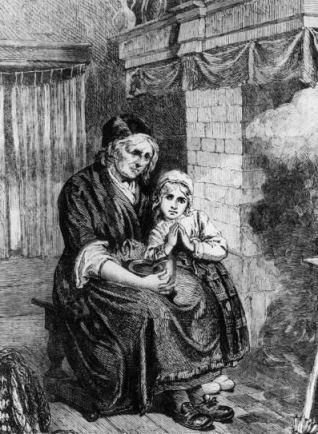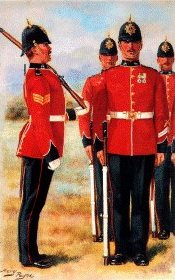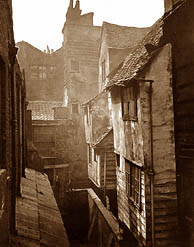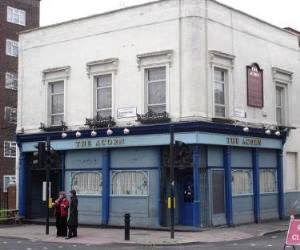hannah mallindine + william harris
Hannah was born in Shoreditch on 6 July 1820, one of ten children born to James Mallindine and Hannah Edghill. She grew up in and around St Leonard in Shoreditch, where she was baptised on 23 July, with her family living in New Inn Yard and later to the east of Shoreditch High Street in the western boundary of Bethnal Green.

Life in the East End was never easy and the struggle to earn enough money to pay the weekly rent and feed the family took its toll on most families and in the 1830s, Hannah’s family had even more challenges to face. When she was twelve years old, her elder sister Rebecca left home and gave birth to an illegitimate son in the Whitchapel Workhouse. Her youngest brother, Joseph, was born the following year and between 1833 and 1841, her mother died. By 1841, her father was living alone and neither Hannah nor her twelve year old sister, Mary Ann, remained with him.
It’s not known when Hannah, also known as Ann, left home but on 18 July 1841, she gave birth to an illegitmate son, Mason, in the Bethnal Green Workhouse and when he was baptised on 30 January 1842, their ‘abode’ was listed as the workhouse although there are no records to confirm whether she stayed following his birth or left and returned some time later. The baptism register lists her occupation as a Horse Hair Weaver, a cottage industry where the long, coarse hair from horse’s manes and tails was woven together with cotton on a standard loom to form a durable fabric often used as furniture upholstery, and she likely learned the basics of the trade from her father and brother-in-law, William Tomkins.
In December 1847, Hannah gave birth to another illegitimate child named Susanna and although no birth registration has been found, her death the following May was recorded and it notes her mother’s name as Hannah, a Horse Hair Weaver, but contains no information on the child’s father. There is no record of what happened to Hannah after her daughter’s death or any mention of Mason until 6 February 1849 when she appeared at the Worship Street Magistrates Court charged with ‘attempting to destroy the life of her child’.
The case was reported in The Times on 8 February, and she was described as ‘a decent looking woman about 30 years of age’ and her son was reported to be about 5 years of age although he was almost 8 so he must have been small for his age. In his testimony to the magistrate, John Stodart, a builder’s clerk, stated that he was standing outside his company office in Haggerston at about 4pm when he saw Hannah lead her son along the banks of Regent’s Canal and when the boy started to resist, she began to drag him before grabbing him and throwing him into the water. She took off her bonnet and shawl apparently intending to jump in as well but Stodart ran over and stopped her before jumping into the canal to rescue Mason.
When witnesses asked why she did it, Hannah burst into hysterical crying and said it was through distress as they were starving and had nothing to eat since the previous day. Another bystander asked if the boy’s father was still alive but ‘she kept on sobbing more compulsively than before and gave no answer.’ The witnesses took Hannah and Mason to a nearby public house, the Acorn on Great Cambridge Street, to wait for the police and when the constable arrived, he found the boy by the fire stripped of his wet clothes and the mother very agitated, crying and sobbing. After hearing the evidence, the magistrate commented that it was a very shocking case but as Hannah had committed such a heinous offence, he felt compelled to send her before a jury and she was taken to Newgate Prison to await trial.
In contrast to The Times, The Standard newspaper described Ann as ‘a squaled and wretched looking young woman in an advanced state of pregnancy’, a fact note mentioned in any other account of her appearance at Worship Street. The Standard also noted that ‘the poor boy was removed to the workhouse’ — the only newspaper to provide this information.
One month later, Hannah stood trial at the Central Criminal Court, known as the Old Bailey, on the charge of ‘feloniously attempting to drown Mason Mallandine, with intent to murder him’. She was represented by Mr. Cooper ‘through the humane instrumentality of the sherriffs’ which may have referred to the period equivalent of a public defender available through legal aid. Hannah was described as being very much affected by the proceedings and wept bitterly throughout the examination.
Stodart testified at the trial and confirmed that on the day, she appeared very wild and in great distress but she said nothing about her husband or the boy’s father and that she took no notice of Mason after he had been pulled out of the canal. The constable was asked if he had made any enquiries about Hannah and he stated he did not and had no information regarding her background or situation to which the judge replied that it was extraordinary that the police had taken no measures to provide the court with any information on the prisoner. At the close of testimony, Mr. Cooper addressed the jury and:
‘he urged upon them that the evidence established the fact that she had committed the act imputed to her in a moment of desperation, brought on by wretchedness and starvation, and that without imputing actual insanity to her, they would be justified in coming to the conclusion that she was in such a state of mind as not to be aware of the effect of the act she was about to commit.’
After deliberating for a short time, the jury returned a verdict of Not Guilty and Hannah was free to go. There is no record of whether Mason was returned to his mother, remained in the workhouse or admitted to another charitable organization neither is there any record of Hannah until 10 years later.
On 19 May 1851, Hannah married 21 year old William Edward Harris at St Philip in Bethnal Green and the register confirms that she was still in contact with her family as her brother-in-law William Tomkins attended as one of the witnesses. Hannah’s address was listed simply as Tyssen Street on the register while William was living at 24 Tyssen Street and working as a Shoemaker when he married. But when the census was taken six weeks before, he was living at 13 Huntingdon Street in Shoreditch with one lodger, 19 year old William Matthews.
But it appears her chance at happiness was shortlived as William married a second time on 23 February 1852 to Eleanor Willett. He was still living at 24 Tyssen Street and working as a Shoemaker but he was listed as a bachelor rather than a widower. No death record has been found for Hannah and it appears she may have still been alive. In 1861, there is a Hannah Harris living at 32 Church Street in Bethnal Green along with her two children, seven year old William and three year old Hannah, who were both born in St Lukes. She was 40 years old, listed as a widow and working as a Horse Hair Weaver. The General Records Office index of birth registrations confirms that a William Edward Harris was born in St Lukes in the third quarter of 1853 and the mother’s maiden name was Mallindine — with a corresponding record for Hannah in 1858 as well. There is also a baptism record for William at St Leonard, Shoreditch on 11 September who was the son of William Edward, a Cordwainer or Shoemaker, and Hannah of 46 Paul Street. Hannah was baptised at St Philip in Bethnal Green on 30 October 1860, the daughter of William Edward, a Shoemaker, and Hannah of 43 Church Street.
If the records above all relate to Hannah and William, it would appear that they separated shortly after they married and William commited bigamy by marrying a second time. It doesn’t seem that his second marriage lasted either as he had reconciled with Hannah by 1853 and they went on to have two children. There is a second marriage for Eleanor Willett as well — to Henry Brown in 1857 — and she is listed in the marriage register as a spinster so it seems they both put their marriage behind them and moved on.
Hannah died four years later and was buried at Victoria Park Cemetery on 10 January 1865. There is no trace of William or a death record to confirm Hannah was actually a widow in 1861 nor any record of their children.

Hannah’s son Mason reappears in the public records when he enlisted in the Army on 21 October 1858 and although his attestation papers list his residence as Finsbury and his occupation as Shoemaker, there is no detailed information on his life between between 1849 and 1858. If he remained in the workhouse, he was probably placed in a residential school or children’s home run by the local Board of Guardians for pauper and orphaned children where he received a basic education in reading, writing and arithmetic as well as training in a trade such as shoemaking, carpentry or blacksmithing.
Mason initially served in the Royal London Regiment of Militia but he was released from further service on the condition that he enlisted in the Light Infantry 13th Regiment of Foot and one month later, his enlistment as a Private was complete. His attestation papers also record that he was 5’ 7" tall with hazel eyes and brown hair.
He remained in the army for 20 years and 341 days, with half that time served abroad, but never rose above the rank of Private. During his first term of engagement, he was stationed in King William’s Town in South Africa for four years and Port Louis in Mauritius for a second term of 4 years. While in Mauritius, he was diagnosed with syphilis for the first time and the only treatment available at the time was a course of painful mercury injections but in most cases, it was only a tempory treatment with relapses being common. Mason completed his first term of service in August 1867 while in Mauritius but he signed on for a second term and several months later, returned to England and a new post in Weymouth on the south coast. By 1868, he had moved to Gosport and was once again treated for syphilis as well as gonorrhea and scabies.
There was one last posting in England, in Aldershot, before his regiment was sent to Ireland and in 1871, he appears in the census at the District Military Encampment in Pembroke, South Wales. The Royal Artillery was based in nearby Pembroke Dock and the town was a main transfer point between Wales and Ireland and it remains so today with many passenger ferries travelling to and from Rosslare. His regiment remained in Ireland for four years and Mason was stationed at Waterford, Kilkenny, Dublin, and Armagh and Belfast in the north.
While in Belfast, Mason met Isabella McGrath and in 1874, they married in Newtonards, a town in County Down to the east of Belfast. The following year, he was transferred to Glasgow and then on to Malta in 1877 and finally Bellary, India in 1878. Isabella travelled to India with him and she gave birth to their son, Mason William, in Bellary on 22 April 1879 but the birth was a difficult one for both mother and baby. Their son was so poorly that he was privately baptised two days later but he recovered enough to complete the baptism rite and was ‘accepted into the church’ on 22 May. Isabella never recovered from the birth and died one week later, on 29 April, with the official cause of death listed as Apoplexy, a general term used to describe, among other things, death from extensive bleeding following childbirth. There is no further record of their son so it seems likely he died in infancy and there is no information to determine if syphillis played any part in Isabella or Mason’s deaths.

Later that year, Mason was granted a discharge on 11 October 1879 and sailed back to England alone on board the HMS Euphrates on 7 November. He advised the army that his intended place of residence was Bow in the East End and two years later, he appeared in the census at 2 Hanks Court in nearby Poplar, lodging with five members of the Butler family. He was entitled to a military pension but it would not have been enough to support him and he was working as a Labourer to supplement his income.
Hanks Court was one of four courts that backed onto the boundary wall of the East India Docks and most of the houses were built between 1825 and 1850 but by the 1880s an investigation by the local authority found them to be ‘damp, badly ventilated and generally dilapidated. It was also noted that the water supply for eight of them came from one leaky tank. They were small houses, eight of them were one-up-one-down dwellings, with rear kitchen or wash-house, and the remainder had a third storey’. The houses in Hank’s Court were closed by the local authority in 1889 and shortly after were demolished to make way for the northern approach to the Blackwall Tunnel under the Thames.
On 8 December 1883, his second child, Susannah Elizabeth, was born at 5 Woolmore Street in Poplar but she died three days later from ‘inanition’ which was a catch all term for babies who did not thrive or could not feed and died shortly after birth. Mason was working as a Dock Labourer and the baby’s mother was listed as ‘Susannah Mallindine formerly Golding’ but no marriage record has yet been found.
Susannah Goldings’s birth record has not been found but most related records place her birth in Poplar in 1839 — 40. She was the daughter of John Thomas Haggar Golding, a Shoemaker, and Susanna Joanna Palmer and grew up in the neighbourhoods surrounding the East India Docks. In 1861, Susannah married Peter McIntosh, registered under the name Susannah Esther Jane, and they had four children before his death in February 1871. Before the year was over, Susannah suffered two more losses when daughters Sarah and Elizabeth died within weeks of each other.
Mason and Susannah haven’t been located in the 1891 census but in the intervening years, they moved to West Ham where he died in the spring of 1896, aged 55 years. Susannah was living alone in a single room at 47 Prince of Wales Road in West Ham in 1901 and ten years later, she was living down the street at number 13, alone and in a single room, and surviving on her old age pension. She died on 9 May 1920 at the Union Workhouse after suffering a stroke caused by a cerebral thrombosis, aged 80 years. Her home address was given as 12 Alnwick Road in West Ham and recorded under profession was ‘widow of Mason Mallindine, Dock Labourer.’ Her daughter-in-law, Harriet MackIntosh, acted as the informant when the death was registered and gave her address as 13 Stephenson Road in West Ham.
Susannah had two surviving sons, Peter and Thomas. Peter married Eliza Jane Blower in 1883 and they had 8 children while Thomas married Harriet Bird and had six children. Thomas died in West Ham in 1930 and Peter in Poplar in 1937.
